| Dec-28-07 | | Resignation Trap: This game was originally scheduled for December 17, but was postponed a few days as Reshevsky was still in transit from the International Tournament in Dallas. See: Game Collection: Dallas, 1957 . |
|
May-15-20
 | | KEG: Many-time US Champion Samuel Reshevsky was the clear favorite as the 1957-1958 US Championship got underway. Who could have imagined that Reshevsky's stranglehold on the US Championship was about to be broken by a 14-year old from Brooklyn. In this game, DiCamillo chose to sacrifice a pawn on move 17. Reshevsky was highly critical of that move, but analysis suggests that the sacrifice was quite reasonable and that DiCamillo lost only because he did not exploit the compensation he initially received for the sacrificed pawn. 1. e4 c5
2. Nf3 d6
3. d4 cxd4
4. Nxd4 Nf6
5. Nc3 g6
The Dragon Variation. As will be seen, Reshevsky had prepared a little surprise in this opening for his opponent. 6. Be3 a6
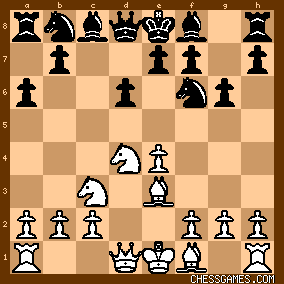
click for larger view6...Bg7 is and was usual here. Reshevsky's move, in addition to its surprise value, eyed the chance at a Queen-side pawn advance and Bb7. The text later became a favorite of British player Simon Williams, and was used on occasion by Shabalov and Lein. It is certainly playable, though most Dragon aficionados looked elsewhere for counterplay in this opening. 7. h3
"?"-- (Reshevsky).
Reshevsky notwithstanding, the text is a reasonable choice here, as are 7. Be2 (the most used alternative) and 7. f3. It was played at least twice by Timman. DiCamillo doubtless expected 7...Bg7 which may well be theoretically best, but Reshevsky had other ideas. 7... b5?!
This double-edged advance leads to all sorts of complications. It went a long way towards making this game the tough and fascinating struggle that ensued. 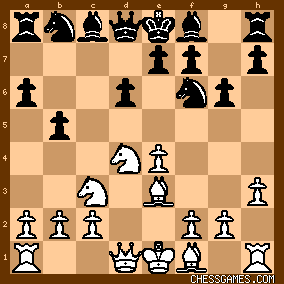
click for larger view8. Be2
Solid and safe, and perhaps the best means of handling an unexpected variation in the opening. The crucial lines to test whether White can obtain any significant edge begin with 8. Nd5 and 8. g4. 8... Bb7
Having said "A," Reshevsky quite reasonably continued with "B." The resulting unbalanced position seems to give chances for both sides. The sharpest choice here was 8...b4?! Reshevsky said this leads to "an unclear position," but his analysis was faulty and White seems to be clearly better: e.g.,
and following Reshevsky's proposed line: 9. Nd5 Nxe4? [This move suggested by Reshevsky should lose. Best though leaving White better placed is 9...Bg7--KEG] 10. Bf3? [Reshevsky's analysis missed the winning 10. Nb5! Bg7 (if 10...axN 11. Bb6 and wins) 11. Nbc7+ Reshevsky's 10. Bf3 is inferior to 10. Nb5, but should also win--KEG]. 10...f5? [10...Nc5 was the only real chance with proper play]. 11. BxN? [Missing the brilliant winning move 11. Nxf5! after which Black has nothing better than 11...BxN (11...gxN? 12. Bb6 winning the Queen since 12...Qd7 runs into 13. Bh5 mate) 12. Bb6 and the coming g4 is brutal--KEG] 11...fxB 12. Nxb4 after which the game is indeed unclear, but White would have had excellent winning chances with 12. Nb5!--KEG. All in all, some very sloppy analysis by Reshevsky. Anyway, back to the game after 8...Bb7

click for larger view9. Bf3
This forfeits any chance of securing any opening edge for White. Better were 9. 0-0; 9. f3; of 9. a4. 9... Nbd7
Reshevsky said that 9...b4 was "playable," but after 10. e5! Black would be in trouble. The text definitely looks best and gives Black reasonable chances. 10. 0-0 Bg7
Reshevsky said that 10...Ne5 was "slightly better," both moves seem to lead to equivalent lines with best play. 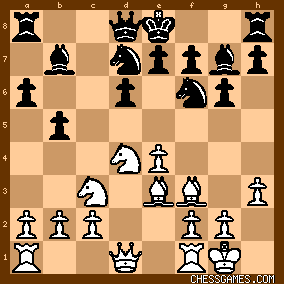
click for larger viewIf Reshevsky had wanted to reach a complicated double-edged position in playing 6...a6, his goal had clearly been achieved. In the above position, the better player--and, more specifically, the better tactician--is likely to come out on top whether playing Black or White. |
|
May-16-20
 | | KEG: Post II
11. a4!
"Attempting to weaken Black's Queen-side Pawns." (Reshevsky) This certainly appears to be the best plans at White's disposal. 11... b4
Reshevsky could also just have castled, but the text is the most aggressive line, and what would be expected from the tournament favorite. 12. Nd5
Far better than the feeble 12. Na2.
12... Ne5
Reshevsky claimed in his commentary on this game that 12...NxN (which looks equally good to me) would have led to trouble for Black. But his analysis was faulty: 12...NxN 13. exN Ne5 14. Nc6 [14. a5 was much better, but White should also be OK with Reshevsky's proposed 14.Nc6--KEG] NxB+ 15. QxN Qc7 [far inferior to 15...BxN, though Black should probably be able to survive even with Reshevsky's suggested move--KEG] 16. Nxb4 Bxb2 [awful play, Black would be fine with 16...0-0--KEG] 17. Rab1 Bg7 18. Nc6 with a big plus to White, but only based on the inferior play by Black in Reshevsky's line. Anyway, let's return to the actual game after 12...Ne5: 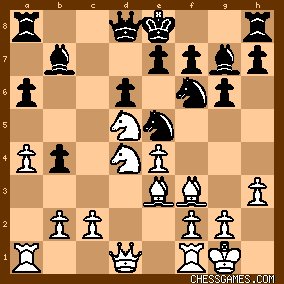
click for larger view13. Nxb4
13. a5 looks simpler and better.
13... Nxe4
Reshevsky's doubts notwithstanding, 13...NxB+ was best. Once again, Reshevsky's suggested line in this variation was flawed: 13...NxB+ 14. gxN [14. NxN and 14. QxN were both better--KEG] 14...Qd7 [14..0-0 was perhaps slightly better--KEG] 15. Kg2 Bc8 [Black would be have the better chances with 15...a5] 16. Rh1 with about equal chances (KEG). Anyway, after the text move (13...Nxe4), the position was: 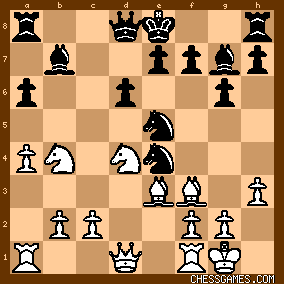
click for larger view14. Nbc6
"!?"--(Reshevsky)
The position was now about even. 14. Ndc6 was probably even better. Following, Reshevsky's analysis: 14. Ndc6 NxB+ 15. QxN Qd7 16. QxN a5 with about even double-edged play. As Reshevsky pointed out, 17. Qxe7+ here would be a mistake in light of 17...QxQ 18. NxQ, but here Black wins with 18...axb4 and not with Reshevsky's awful 18...KxN which would put White on top after 19. Nd3 (rather than Reshevsky's 19. Bg5+ f6). In the above variation, best for White would be 17. Nd5 with about an even game. 14... NxN
15. BxN d5
16. Bf3
Better was 16. NxN.
16... Na5
As Reshevsky correctly pointed out, 16...NxN 17. BxN e5 18. Bc5 would prevent Black from castling King-side. The text, or 16...Ne5 (which Reshevsky said"would have served approximately the same purpose as the text-move") were best. After 16...Na5, the following key position in the game was reached: 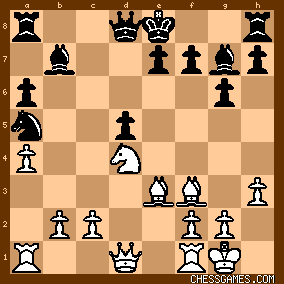
click for larger viewAs a result of DiCamillo's second-best 16th move, Black here has slightly better chances. Probably recognizing this, DiCamillo embarked here on a dynamic sacrifice that Reshevsky severely--and in my view unfairly--criticized. I will discuss all this in my next post on this game. |
|
May-16-20
 | | KEG: Post III
DiCamillo might have tried to play it "safe" here with something like 17. b3. Alternatively, he might have tried some mild Queen-side play with 17. b4. But these would have left him trying to hold a slightly inferior position against a fine tactician (Reshevsky). My teacher Susan Polgar frequently reminds me that chess at its best is a battle of ideas. Here, DiCamillo tried something creative: a pawn sacrifice to obtain some initiative and counterplay--and deprive (at least temporarily) Black of the chance to castle. Was this best play? All in all, this is hard to tell. [For what it's worth, I fed the position to Fritz and Stockfish which both duplicated DiCamillo's 17. Nb3]. One things is for sure, the pawn sacrifice made the game. But there is was one critical point. Having sacrificed the pawn, DiCamillo had to follow it up vigorously. This is failed to do, and thus found himself trying to fend off Reshevsky a pawn down. Not surprisingly, this didn't work out so well. Anyway, back to the game:
17. Nb3!?
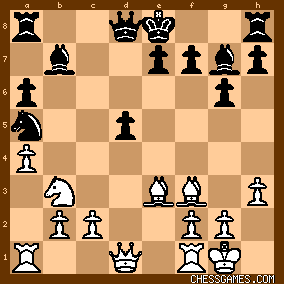
click for larger view17... NxN
Reshevsky decided to take the offered pawn.
Reshevsky says that here, rather than accepting the pawn sacrifice, he could have "won the Queen at the expense of three pieces for the Queen [actually for two minor pieces and a Rook]..." but that White would then have had "the better chances." His analysis, as with much of his commentary on this game, is badly flawed, and in reality the line results in approximately equal chances: 17...Nc4?! 18. Bd4 Nxb2 [very bad--Black holds his own with 18...BxB--KEG, after 18...Nxb2, Black is lost] 19. Bxg7 [another weak move, which blows the win which White would have with the simple 19. Qb1!--KEG] NxQ 20. BxR f6 21. RaxN Kf7 22. Nc5 Bc6 23. c4 [23. Bxf6 is better--KEG] QxB [23...Qd6 or 23...Qb6 are better, while Resheveky's alternate 23...e6? gets crushed as Reshevsky recognized: 24. Rfe1 QxB [suicide, 24...Qb6 or 24...Qa5 were better chances, though Black is still lost--KEG] 25. Rxe6 Rc8 [25...Bd7 is slightly better, though still losing--KEG] 26. cxd5 [26. RxB is a much faster win--KEG] Be8 [hopeless, Black's only shot is 26...Bxd5] 27. d6--KEG] So much for that, back to the actual game after 17...NxN 18. cxN Bxb2
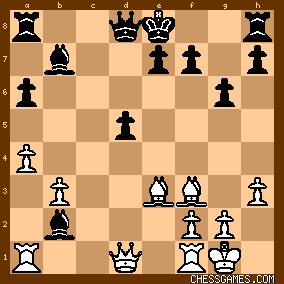
click for larger view19. Ra2!
"!"--Reshevsky.
As Reshevsky pointed out, after 19. Rb1 Bg7 White "...has nothing at all to show for the Pawn. With the text-move White at least prevents his opponent from castling." 19... Bf6
"If 19...Bg7, White prevents Black from castling by playing 20. Rd2 (the purpose of White's 19th move now becomes apparent) e6 21. Bc5." (Reshevsky). The above analysis is correct as far as it goes. But two further points need to be added: (i) Black is still slightly better on the above line; and (ii) 19...Bg7, despite its problems, is superior to Reshevsky's actual move. After 19...Bf6, the position was:
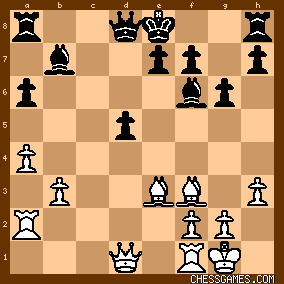
click for larger viewDiCamillo definitely had some compensation here and the position was unclear. But from this point, Reshevsky outplayed his opponent. 20. Bh6 e6
Now, as noted by Reshevsky, Black had to figure out how to bring his h8 Rook out of quarentine. 21. Re1
21. Rd2 or 21. b4 were stronger, but the text wasn't awful. 21... Qd6
Reshevsky noted that 21...Bg5 would accomplish nothing for Black giving the following line: 21...Bg5 22. Bg7 Rg8 23. Qd4 [or 23. Bc3 or 23. Bd4 or 23. Bb2--KEG--in any case with about equal chances for both sides]. 
click for larger viewSo far so good for DiCamillo's pawn sacrifice. Beginning in this position, however, he blew his counterplay and suffered the fate of any player giving Reshevsky a pawn for free. |
|
May-16-20
 | | KEG: Post IV
22. Rc2?
A tempting but mistaken plan that began DiCamillo's relinquishment of his counterplay. Best was 22. Bg4! Then, if 22...Kd7 23. Qf3; and if 22...Ke7 23. Bc1. Thus, Black's h8 Rook would remain locked in the corner for at least a while, since Reshevsky would have had nothing better than 22. Rc8 23. Rae2 with chances for both sides. After the text, Reshevsky was able to untangle his forces with: 22... Kd7!
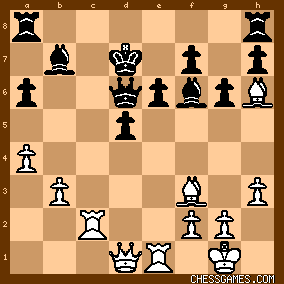
click for larger viewAll of a sudden, Reshevsky's forces seemed ready to spring to life. To retain any compensation for the sacrificed pawn, DiCamillo would have had to play with careful vigor from here. But: 23. Qd2?
As Morphy and Andersen from a century earlier could have told DiCamillo, this is not the way to play a gambit! There was no time to dork around with Reshevsky holding an extra pawn. To have any real chance, he had to play 23. Bc1 and 24. Ra2 (or in reverse order) and focus on an immediate attack. With the text, DiCamillo gave Reshevsky time to begin his own counterattack. 23... Rac8
I was surprised that Reshevsky didn't motor the other Rook here with 23...Rhc8, but I'm not sure this really mattered. 24. Rec1
"White cannot avoid the exchange of Rooks." (Reshevsky) This is true, but 24. Rcc1 was the best of a host of bad choices for DiCamillo here. 24... RxR
25. RxR Rc8
26. RxR BxR
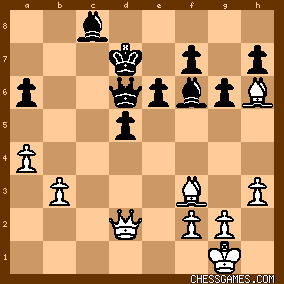
click for larger view27. b4?!
DiCamillo, seeing his counterplay vanishing before his eyes, perhaps felt compelled to try some aggressive Queen-side demonstration. But this only sped his demise. He had nothing better than to sit tight with 27. Bg5 or 27. Be2 or 27. Bg4. 27... Qe5
"Black is threatening to force the exchange of Queens." (Reshevsky) All true, and this plan might--even against best play--had prevailed in the end, especially with Black having a protected passed d-pawn. But the most effective way to punish DiCamillo's temerity was via 27...Be7! After 27...Qe5, the position was:
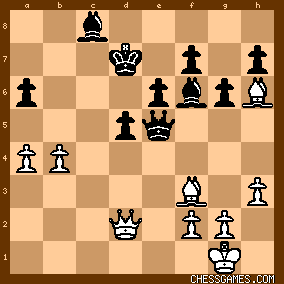
click for larger view28. Be3?
Giving up without a fight.
Reshevsky correctly stated that 28. b5 was inadequate, but it was not as bad as Reshevsky's line would suggest and was in fact better than the text: 28. b5 axb5 [Black could just as well play 28...Qa1+ immediately--KEG] 29. axb5 Qa1+ 30. Kh2 Qb2 "...and White is compelled to trade Queens because of the threat of Be5+" (Reshevsky). But White should play 30. Bd1, and now if 30...Qb2 31. Qf4 with very real counterchances (better is 30...Bb7). But best for White in the diagrammed position is 28. Be2 so that if 28...Qc3 29. Qf4 with serious counterplay. Best for Black after 28. Be2 would be 28...Qd4 29. b5 leaving White some chances after the exchange of Queens, or after 29...Qxa4 30. Qe3. Once again, I doubt that any of this would ultimately have saved the day for White. But it was worth a shot. After the text, Reshevsky mopped up:
28... Qc3
28...Qa1+ was even stronger, but the text did the trick and is a clearer and simpler line in over-the-board play. 29. QxQ
29. Bd1 was slightly better.
29... BxQ
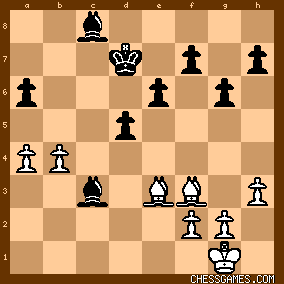
click for larger viewWhile resignation would probably be premature here, this ending does not look like any fun to play out from the White side. |
|
May-16-20
 | | KEG: Post V
30. Bc5
Reshevsky correctly pointed out that 30. b5 axb5 [30...Kd6 also wins easily--KEG] 31. axb5 Kd6 (or, even better, 31...Kc7--KEG] "White is in bad shape." Of course, White was also in pretty bad shape even with the text (which was probably best). 30... Kc6
"...threatening to win a Pawn with ...a5." (Reshevsky) 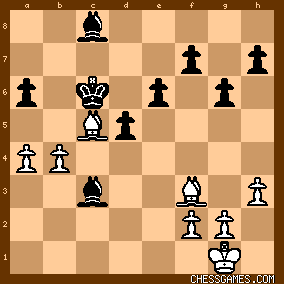
click for larger view31. Be2 Be5
Needlessly prolonging the struggle. 31....e5 was fastest. 31...d4 or even 31...f5 were also quicker finales as compared with the text which--in fairness to Reshevsky--also wins, though with a tad more trouble. 32. Bf8
32. f3; 32. a5; and 32. g4 all offered slightly stiffer resistance. 32... Bd6

click for larger view33. b5+
Losing a second pawn almost immediately. If DiCamillo wanted to extend the game, he had to play 33. BxB. But, as will be seen, with the text DiCamillo was setting a nasty trap for Reshevsky. So perhaps, from a practical standpoint, the text was best. 33... axb5
34. axb5+
"34. Bxb5+ was slightly better." (Reshevsky)
This is perhaps true from a theoretical perspective, but--as noted above--DiCamillo was about to spring a last gasp try to derail Reshevsky. 34... Kc5
35. Bh6
Once again, I could quibble and argue some slight theoretical preference for 35. Bg7. But all that is irrelevant. DiCamillo was apparently staking all on his next move. 35... Bd7
So now the b5 pawn is lost, right?
36. Bc1!

click for larger viewNow, as explained in Reshevsky's commentary on the game, Black could have ruined everything with the hasty and seemingly obvious 36...Bxb5. This, however, would allow Black to regain the pawn [and perhaps even save the game--KEG] after 37. Ba3+ Kb6 38. BxB(b5) BxB (a3) 39. Be8 and now if 39...f5 [the only move considered by Reshevsky] White has excellent drawing chances with 40. Bf7! as pointed out by Reshevsky. Perhaps 39...e5 or 39...Kc5 were slightly better, but even then the win in the Bishop and Pawn ending would have been far from easy. But Reshevsky avoided all these problems with the careful: 36... Kb6!

click for larger viewNow, DiCamillo had to lose a second pawn, and the game. 37. Be3+ Bc5
The most accurate parry.
38. Bg5 Bxb5
39. Bd8+ Kc6
40. Bd1 e5
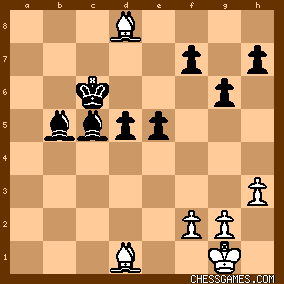
click for larger view0-1 |
|
|
|
|





